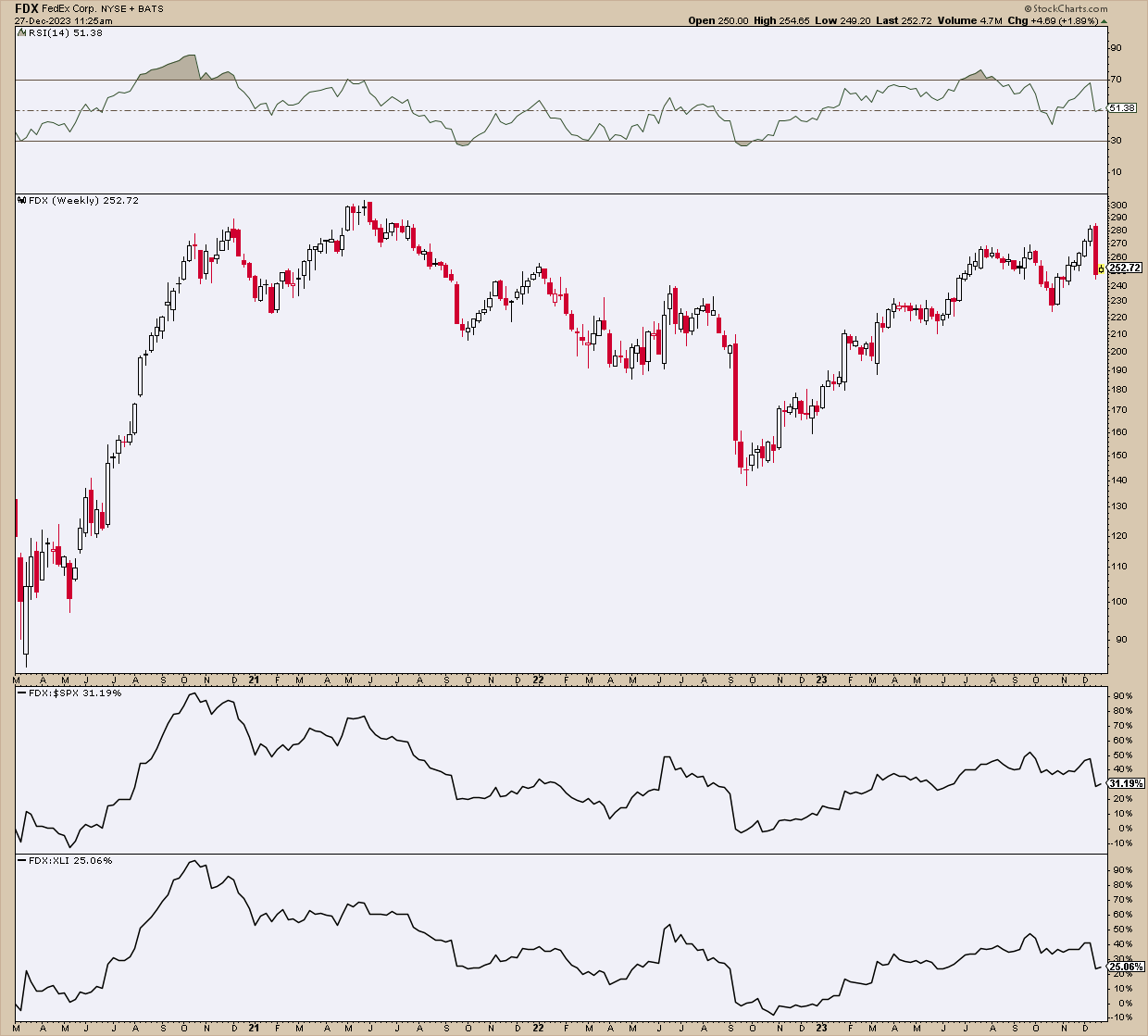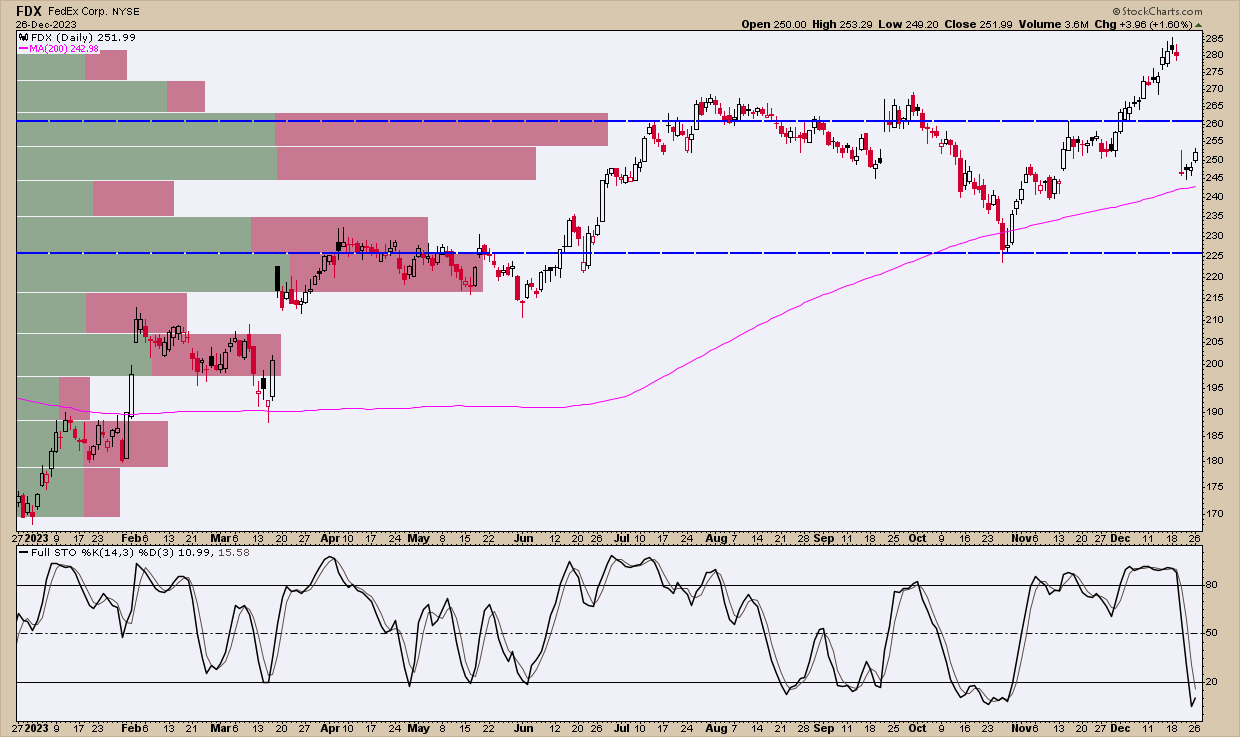
Santa Claus might have had a lot of presents to deliver this holiday season but whatever burst of activity happened leading up to the last few weeks, it wasn’t enough to help FedEx (FDX) meet Wall Street’s expectations. Suppressed demand resulting in a huge earnings miss and muted full-year sales outlook all contributed to its dramatic 12% drop last week.
Suppressed demand may have weakened FedEx’s performance, but on a macroeconomic scale, it’s an extremely difficult thing to try to predict. But from a technical analysis perspective, you can at least see where the inflection points might be, even if the fundamental picture remains too foggy to look ahead.

CHART 1. WEEKLY CHART OF FEDEX (FDX). Note FedEx’s muted performance against the broader market and the Industrial sector. Chart source: StockCharts.com. For educational purposes.
FDX fell sharply last week, just 6% shy of its all-time high of $304.36. Having entered overbought territory last summer, the latest drop brought FedEx’s relative strength index (RSI) reading down to 50. Technically, it has some upside room to run, which is somewhat promising, considering that FedEx’s longer-term uptrend is still intact. It would have to close below $223.62, its October swing low, before its uptrend may be invalid.
Plus, looking at FedEx as a bellwether for global economic trade, its price action relative to the S&P 500 ($SPX) and the Industrial Sector (XLI) demonstrates muted yet recovering performance. Looking at the charts, you can see the effects of suppressed demand followed by a modest recovery.
On a more near-term scale, what does its price action indicate?

CHART 2. DAILY CHART OF FDX STOCK. There are many key levels surrounding FedEx’s price action based on the stochastic oscillator and volume-by-price bars. It provides a context to anticipate the stock’s longer-term trajectory. Chart source: StockCharts.com. For educational purposes.
The stock price is hovering between $250 and $255. Last week, its downward gap found support right above its 200-day SMA. The stochastic oscillator, now well below the 20 line, is deep in oversold territory.
If FedEx gathers enough strength to rally, note the blue dotted line above $260. You’re not looking at the series of highs from July to September but at the blue line which, marks the higher part of the volume by price bar and sits near the middle of the price gap which, in many cases, tends to get filled. The volume by price bar shows the tremendous selling that took place at this price, making it a strong resistance area to watch.
Conversely, the same can be said of the blue bar below the price. This level coincides with the November low, the highs in March through May (resistance turned support?), and another notable volume by price level, all indicating a potential support range. If price breaks below the 200-day simple moving average (SMA), the $225 range will likely provide ample support.
The Bottom Line
We may not be able to predict how the macroeconomic winds will blow in the next quarter, at least with regard to global deliveries. But the market’s early guesses can be detected and possibly anticipated by watching these key levels. In other words, keep an eye on price within this general context. One effective way would be to set price alerts at these key levels.
How To Set a Technical Price Alert

Setting a technical alert at these support and resistance levels would be helpful as you weigh your potential entry points against any market developments that may influence your decision.
To access the Technical Alert Workbench, follow these steps:
- Log in to your account.
- At the top of any page, click on “Your Dashboard”.
- From Your Dashboard, click the Alerts button or the “New” button in the Your Alerts panel.
- In the Alerts workbench, choose which type of alert you want to create from the “Alert Type” buttons at the top left. To create a price alert, select “Price Alert” as the alert type.
- Add COST in the symbol box and set your price trigger.
- Choose how you wish to be notified and click the Save Alert button.
Disclaimer: This blog is for educational purposes only and should not be construed as financial advice. The ideas and strategies should never be used without first assessing your own personal and financial situation, or without consulting a financial professional.

